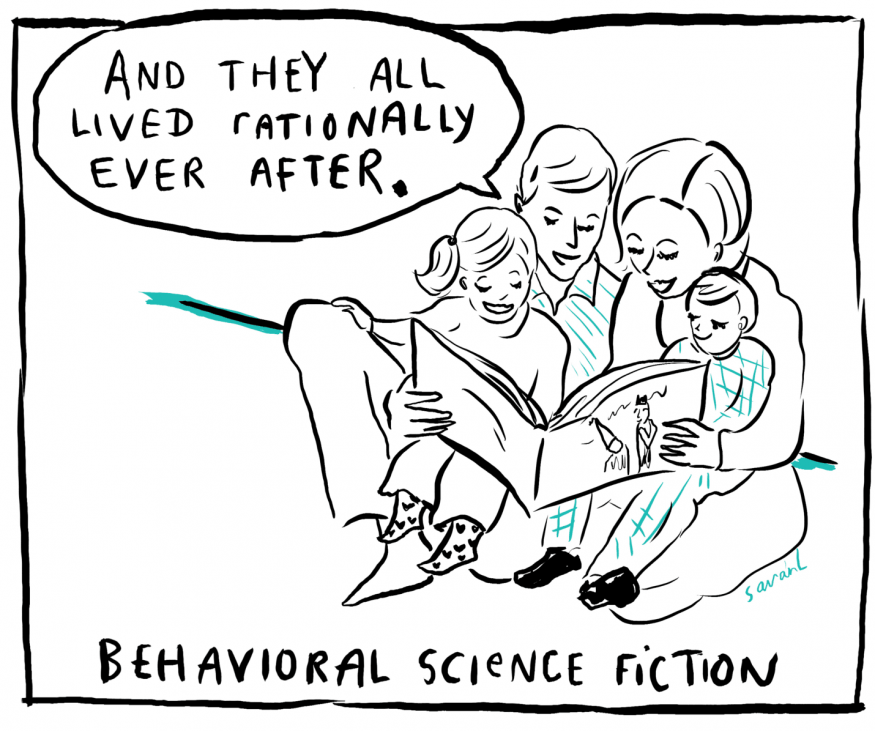
EVAN DAVIS – APRIL 13TH, 2023
EDITOR: ARYAN SHAFAT
My best friend’s breathing was picking up as the sun set on the horizon. Our mountain biking trip was quickly about to become a ride through the darkness.
I grabbed his shoulder. “Myles, calm down. Let’s be rationa-“
He violently twisted, throwing my arm off, kickstarted his bike, and sped on down the road, panic twisting his face. He later told me he was overcome with raw terror at the thought of the impending darkness.
“He could die,” I thought to myself. The mountain road, while paved, was a series of twists and turns with cliffs on either side and potholes abound. If he went off the side, it would be a quick and fatal plummet.
This is an extreme example of emotion overtaking one’s rational judgment. But it happens to all of us, all the time. Psychology permeates our everyday lives, affecting the way we make our decisions.
When you combine psychology and economics, you get an approach known as behavioral economics. Economies are made up of people taking action, and psychology is the study of how people act – it seems intuitive that the two fields should complement each other. Yet, for the longest time, and even now, orthodox economics typically leaves psychological analysis out of its models.
Rational expectations theory, rational preferences, and rational choice theory are assumptions made in most mainstream economic models. Rational choice theory essentially posits that individuals act as optimizing agents, rationally and coherently analyzing all given choices with their costs and benefits to determine the best course of action. Rational preferences are “well-behaved” preferences, which are both transitive (A being preferred to B and B being preferred to C means A is preferred to C) and complete (preferences encompass all possible choices the agent must make). Rational expectations theory extends rationality theory to the macroeconomic level. It acknowledges that while people make mistakes, their predictions about the economy are based on rational analysis of knowledge about how the economy actually works, and as such, people’s predictions about the economy are usually correct on aggregate.
Behavioral economics’ primary contribution to economic theory has been to challenge the mainstream assumption of rationality. As University of Chicago’s economics department states, mainstream neoclassical-Keynesian economics assumes that “most people have well-defined preferences and make well-informed, self-interested decisions based on those preferences.” In other words, people are rational. Yet, substantial empirical evidence exists showing that people can be “irrational.” New theories of rationality, such as bounded rationality (the idea that individuals will simply make choices they find satisfactory, rather than optimal choices), have popped up, challenging the orthodox view.
This is not to say that the mainstream is unaware of behavioral economics and irrationality. For starters, behavioral and experimental economists such as Daniel Kahneman, Richard Thaler, and Vernon Smith have won the Nobel Prize for their work. Mainstream models have also started integrating behavioral findings into their assumptions, such as time inconsistency (which you learn about if you take math-intensive microeconomics under Professor Stefano DellaVigna, a behavioral economist here at Berkeley). Work has been done defending mainstream economic conclusions without relying on its rationality assumptions. For instance, a simulation done by economists at Carnegie Mellon showed that auction-like markets can bring about efficient static resource allocation, even when the participants are very irrational (“zero intelligence traders” who act randomly are much more irrational than people are in reality).
Since the mainstream recognized the validity of numerous behavioral propositions, a lot of work has been done synthesizing behavioral and neoclassical economics, as well as behavioral and orthodox Keynesian macroeconomics. The field has become so well-respected that some have argued that behavioral economics is the new mainstream approach to rationality.
Behavioral Heterodox Economics
Despite behavioral economics being more accepted in mainstream economics, the orthodoxy still generally adheres to theories of rationality. However, behavioral economics has succeeded in exerting a substantial amount of influence over alternative, heterodox approaches to economics as well – notably the Austrian and heterodox Keynesian, or Post-Keynesian, schools of economic thought. Both the Austrian and Post-Keynesian schools of thought focus on the subjective experiences of people in an economy. Both recognize that people’s knowledge and expectations are shaped through the passing of time, and that they follow “rules of thumb” via bounded rationality in a world of unquantifiable uncertainty. The primary benefit of markets, in their eyes, is less so efficient static allocation of resources, and more so the dynamic progress provided by creative, entrepreneurial action. Hence, both approaches recognize that people are not the perfectly rational, knowledgeable beings generally assumed in neoclassical or mainstream Keynesian economics. Neither approach is inherently opposed to behavioral analysis.
Despite behavioral economics often centering around people’s irrationality, it doesn’t necessarily promote government intervention in the economy. Austrian economists are known for being especially supportive of laissez-faire capitalism. Yet, unlike their mainstream free-market counterparts, Austrian economists do not assume transitive preferences or completely rational decision-making in their models. Some Austrians, such as economist Ludwig von Mises, conceive of all action as inherently “rational” in the sense that it’s aimed at some sort of conscious or subconscious desire over the person. Mises notes that calling action irrational requires imposing an external value judgment upon the action. However, this form of rationality is tautological, and is consistent with the observed ‘irrationality’ of behavioral economics, in contrast to the theoretical rationality of neoclassical economics.
Economist Gustavo Cevolani argues that Austrian and behavioral (particularly experiment-based) economics share common themes of subjectivism and methodological individualism (focusing on the actions of individual people), and thus can enrich one another. Indeed, many economists have utilized behavioral economics to empirically support certain Austrian theories with psychological components. Austrian economists Powell and Oprea argue that the results of laboratory psychological experiments testing Austrian hypotheses can be generalizable to an economy, while 2002 Nobel Laureate Vernon Smith argues that behavioral experiments lend observational credence to the Austrian proposition that prices convey decentralized information about the economy to individuals, and result in efficient gains from trade. In their book The Economics of Time and Ignorance, Austrian economists Rizzo and O’Driscoll argue that the findings of behavioral economics strengthen the Austrian approach.
Behavioral economics also shares common themes with the economics of Keynes. Keynes argues in his treatise The General Theory of Employment, Interest, and Money that investors in an economy are driven by irrational psychological urges to invest, which he coined ‘animal spirits.’ Although modern Keynesian economists often adhere to rational expectations theory, the more heterodox Post-Keynesians certainly do not. Post-Keynesian economist Marc Lavoie argues that while behavioral economics is too friendly to orthodox views of what counts as “rational behavior” (a view he somewhat shares with the Austrians), it nonetheless demonstrates bounded rationality, which he identifies as one of the core bases of Post-Keynesian microeconomics. In the realm of Post-Keynesian macroeconomics, economist Hyman Minsky developed a highly psychology-based theory of the business cycle known as the Financial Instability Hypothesis. The theory posits that in times of propensity, economic confidence (similar to Keynesian ‘animal spirits’) prompts investors to make risky investments which they can’t pay off in the end. Their failure to pay off their debt results in a crash. Some of the theory’s psychological components have even been critically accepted by certain Austrian economists. And while economists Therese Jefferson and J.E. King argue that while Post-Keynesian and behavioral economics have not had much explicit interaction to date, there is plenty of room for the two schools to enrich each other. Economist Matthew Fung points out in a response to Jefferson and King that behavioral economics has contributed quite a bit to Post-Keynesian microeconomic theory; for instance, it found out that all other things being equal, groups of people will behave more risky than individuals, which helped develop the Post-Keynesian theory of the firm.
Behavioral economics has also supplemented further alternative/applied fields of economics. Behavioral approaches to environmental economics have allowed environmental policymakers to work outside the bounds of rational choice and rational expectations theory, applying psychological findings and nudge theory to environmental policy. Work even exists applying behavioral economic analysis to Marxian economics. For example, economists Jeffrey Carpenter and Peter Matthews connect the irrational behavior of individuals to their economic class (capitalist or worker).
Paternalism vs Markets
Behavioral economics has shown that people aren’t always ‘rational.’ Now, what?
Many behavioral economists believe that irrational behavior is simply a vice which policy can overcome. These paternalistic behavioral economists advocate something known as ‘nudge policy.’ In essence, nudge policy involves psychological ‘nudges’ people towards making “better” and “more rational” choices. For example, placing water closer to the cash register in a store than soda psychologically ‘nudges’ people to choose water over soda, simply by making the water more prominent and easier to access than the soda. This sort of policy works well. Nudge policy has succeeded in increasing the number of registered organ donors by making organ donation an opt-out rather than opt-in. Simple reminder messages increased the number of people signing up for doctor’s appointments or filing for student aid. Providing people with information regarding their and their neighbors’ energy usage reduced energy usage. Case in point, examples are numerous. Nudge policy provides a way for policymakers to respect freedom of choice while promoting socially optimal outcomes; by simply encouraging better choices rather than outright banning bad ones.
However, not all economists agree that nudge policy is optimal. First off, the precedent it sets is dangerous when taken to its logical conclusion. If people can be irrational in a market context, what makes them any more rational when it comes to voting? This is empirically substantiated. Yet, if we were to adopt ‘nudge’ policies when it came to voting, this could very quickly become extremely anti-democratic and very easy for the state to abuse towards its own ends.
Secondly, as economist Mario Rizzo notes, there is a potential knowledge problem with paternalistic nudge policy. In essence, nudge policy is meant to optimize behavior by eliminating irrational action, namely action which fails to achieve the given individual’s actual goal. However, paternalistic nudge policy assumes that the policymaker understands the individual’s goal better than the individual themselves. What is “rational” vs “irrational” is subjectively defined by the institution (government or other group) pushing the nudge policy, instead of by the individual. However, the institution is made up of people, just as irrational as any consumer. The difference is, the consumer understands their own desires, and the choices they can make to best satisfy those desires, better than any planner does. The consumer can be wrong, yes, but the planner doesn’t even know what the consumer wants or what their choices are. Wichita State University economist Abigail Devereaux compares nudge policy’s knowledge problem with socialism’s knowledge problem: that a socialist central planner is incapable of determining consumer desires without prices to signal consumer demand. The fallacy is fundamentally the same: the policymaker is assumed to have superior knowledge of consumer desires and available choices than the consumer themselves.
Regardless of whether or not behavioral economics is a valid justification for paternalistic government policy, it has succeeded in challenging the way we traditionally think about economics. Not only has it successfully influenced mainstream neoclassical and Keynesian economics, but it has opened the door to research validating alternative subjectivist approaches to economic theory. It has also contributed unique insights to applied forms of economics, allowing us to better understand what drives social and material phenomena such as climate change.
As for my friend Myles and I, we eventually made our way down the mountain to safety. But, the experience taught me that emotion can easily cloud one’s judgment, and demonstrated how irrationality lies in wait around every corner.
Featured Image Source: Behavioral Scientist
Disclaimer: The views published in this journal are those of the individual authors or speakers and do not necessarily reflect the position or policy of Berkeley Economic Review staff, the Undergraduate Economics Association, the UC Berkeley Economics Department and faculty, or the University of California, Berkeley in general.



